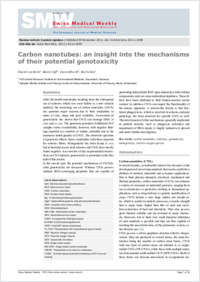Carbon nanotubes: an insight into the mechanisms of their potential genotoxicity
- Berlo, Damiën van IUF-Leibniz Research Institute for Environmental Medicine, Dusseldorf, Germany
- Clift, Martin J. D. Adolphe Merkle Institute and Fribourg Center for Nanomaterials, University of Fribourg, Switzerland
- Albrecht, Catrin IUF-Leibniz Research Institute for Environmental Medicine, Dusseldorf, Germany
- Schins, Roel P. F. IUF-Leibniz Research Institute for Environmental Medicine, Dusseldorf, Germany
-
05.11.2012
Published in:
- Swiss Medical Weekly. - 2012, vol. 142, p. w13698
English
After the health catastrophe resulting from the widespread use of asbestos which was once hailed as a new miracle material, the increasing use of carbon nanotubes (CNTs) has spawned major concern due to their similarities in terms of size, shape and poor solubility. Assessment of genotoxicity has shown that CNTs can damage DNA in vitro and in vivo. The genotoxic potential of different CNT samples varies considerably, however, with negative findings reported in a number of studies, probably due to the enormous heterogeneity of CNTs. The observed spectrum of genotoxic effects shows similarities with those reported for asbestos fibres. Mutagenicity has been found in vivo but in bacterial assays both asbestos and CNTs have mostly tested negative. An overview of key experimental observations on CNT-induced genotoxicity is presented in the first half of this review.In the second part, the potential mechanisms of CNT-elicited genotoxicity are discussed. Whereas CNTs possess intrinsic ROS-scavenging properties they are capable of generating intracellular ROS upon interaction with cellular components, and can cause antioxidant depletion. These effects have been attributed to their Fenton-reactive metals content. In addition, CNTs can impair the functionality of the mitotic apparatus. A noteworthy feature is that frustrated phagocytosis, which is involved in asbestos-induced pathology, has been observed for specific CNTs as well. The involvement of other mechanisms generally implicated in particle toxicity, such as phagocyte activation and impairment of DNA repair, is largely unknown at present and needs further investigation.
- Faculty
- Faculté des sciences et de médecine
- Department
- AMI - Bio-Nanomatériaux
- Language
-
- English
- Classification
- Biological sciences
- License
-
License undefined
- Identifiers
-
- RERO DOC 31322
- DOI 10.4414/smw.2012.13698
- Persistent URL
- https://folia.unifr.ch/unifr/documents/302745
Statistics
Document views: 187
File downloads:
- pdf: 233
